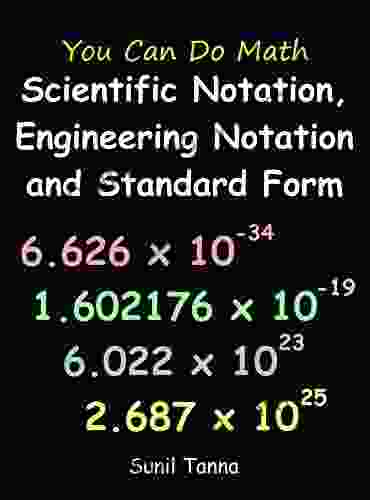Scientific Notation, Engineering Notation, and Standard Form: A Comprehensive Guide

In the vast landscape of mathematics, engineers, scientists, and students alike often encounter complex numerical expressions that require a concise and efficient representation. Scientific notation, engineering notation, and standard form offer powerful tools for expressing such numbers in a simplified manner, making them easier to understand, compare, and manipulate. This comprehensive guide will delve into the intricacies of these notations, empowering you to master their use and unlock a deeper understanding of numerical expressions.
Scientific notation, also known as exponential notation, provides a compact way to represent extremely large or small numbers in a form that is easy to read and interpret. It expresses numbers as a product of two factors:
- Coefficient: A number between 1 and 10, excluding 10.
- Base: The number 10 raised to a specific exponent.
x 10
5 out of 5
| Language | : | English |
| File size | : | 1703 KB |
| Text-to-Speech | : | Enabled |
| Screen Reader | : | Supported |
| Enhanced typesetting | : | Enabled |
| Word Wise | : | Enabled |
| Print length | : | 356 pages |
For example, the number 602,214,129,000,000,000,000,000 can be expressed in scientific notation as:
6.02214129 x 1023
To convert a number to scientific notation, follow these steps:
- Move the decimal point to the right until the first non-zero digit appears to the left of it.
- Count the number of places the decimal point was moved. This becomes the exponent.
- The coefficient is the original number with the decimal point removed and a 1 added to the left.
To convert a number in scientific notation to standard form, reverse the process:
- Move the decimal point to the right by the exponent.
- Add zeros as needed to fill in any empty spaces.
Engineering notation is a variation of scientific notation specifically designed for use in engineering applications. It employs a slightly different exponent convention to simplify the representation of numbers that are multiples of powers of 1000.
x 103n
where:
- Coefficient: A number between 1 and 1000, excluding 1000.
- Exponent: A multiple of 3 (e.g., 3, 6, 9, etc.).
To convert a number to engineering notation, follow these steps:
- Divide the number by the highest power of 1000 that is less than or equal to it.
- The coefficient is the result of the division.
- The exponent is the quotient of the division divided by 3.
To convert a number in engineering notation to standard form, multiply the coefficient by 1000 raised to the exponent.
Standard form, also known as decimal form, is the most common way to represent numbers. It uses place value to indicate the magnitude of each digit, with each digit multiplied by a power of 10 based on its position in the number.
.
where:
- Whole number: The integer part of the number.
- Fractional part: The decimal part of the number.
Scientific, engineering, and standard form have numerous applications across various fields, including:
- Physics: Expressing physical constants, such as the speed of light or Avogadro's number.
- Chemistry: Representing the concentration of substances in solutions or the molecular weights of compounds.
- Engineering: Performing complex calculations involving large or small numbers in fields such as electrical engineering, mechanical engineering, and civil engineering.
- Mathematics: Simplifying and comparing numerical expressions, solving equations, and performing operations on matrices.
- Finance: Expressing large financial amounts, such as national debt or corporate profits.
Mastering scientific notation, engineering notation, and standard form is essential for anyone navigating the complexities of numerical expressions in science, engineering, and mathematics. This comprehensive guide has provided you with a solid foundation in these notations, equipping you with the knowledge to express, compare, and manipulate numbers effectively. Remember, practice is key, so continue to apply these principles in your academic and professional pursuits, and you will undoubtedly become proficient in using scientific, engineering, and standard form to simplify and enhance your understanding of complex numerical expressions.
5 out of 5
| Language | : | English |
| File size | : | 1703 KB |
| Text-to-Speech | : | Enabled |
| Screen Reader | : | Supported |
| Enhanced typesetting | : | Enabled |
| Word Wise | : | Enabled |
| Print length | : | 356 pages |
Do you want to contribute by writing guest posts on this blog?
Please contact us and send us a resume of previous articles that you have written.
 Book
Book Novel
Novel Page
Page Chapter
Chapter Text
Text Story
Story Genre
Genre Reader
Reader Library
Library Paperback
Paperback E-book
E-book Magazine
Magazine Newspaper
Newspaper Paragraph
Paragraph Sentence
Sentence Bookmark
Bookmark Shelf
Shelf Glossary
Glossary Bibliography
Bibliography Foreword
Foreword Preface
Preface Synopsis
Synopsis Annotation
Annotation Footnote
Footnote Manuscript
Manuscript Scroll
Scroll Codex
Codex Tome
Tome Bestseller
Bestseller Classics
Classics Library card
Library card Narrative
Narrative Biography
Biography Autobiography
Autobiography Memoir
Memoir Reference
Reference Encyclopedia
Encyclopedia Thomas Kelly
Thomas Kelly Stanley Cohen
Stanley Cohen Laurent E Calvet
Laurent E Calvet Henry Warren
Henry Warren Ilhan Omar
Ilhan Omar Robert Bryndza
Robert Bryndza Tony Hawk
Tony Hawk Michelle Cunningham
Michelle Cunningham Rob Walling
Rob Walling Paula Harrison
Paula Harrison Maya Payne Smart
Maya Payne Smart Mark Reynolds
Mark Reynolds Mariusz Wilk
Mariusz Wilk Helen Lester
Helen Lester Mark T Conard
Mark T Conard Helen K Emms
Helen K Emms Mike Rothschild
Mike Rothschild Ian Sample
Ian Sample Helen Wilkie
Helen Wilkie Yasmin Akhtar
Yasmin Akhtar
Light bulbAdvertise smarter! Our strategic ad space ensures maximum exposure. Reserve your spot today!

 Jace MitchellIt's Not What You're Eating, It's What's Eating You: How Stress and Emotional...
Jace MitchellIt's Not What You're Eating, It's What's Eating You: How Stress and Emotional...
 George Bernard ShawMore Lessons and Teachings: A Guide to Personal Growth and Spiritual...
George Bernard ShawMore Lessons and Teachings: A Guide to Personal Growth and Spiritual...
 Gerald ParkerHildegard von Bingen: Mystical Visions and Divine Healing in the Middle Ages
Gerald ParkerHildegard von Bingen: Mystical Visions and Divine Healing in the Middle Ages Roberto BolañoFollow ·2.2k
Roberto BolañoFollow ·2.2k Dwight BellFollow ·2.7k
Dwight BellFollow ·2.7k Christopher WoodsFollow ·9.2k
Christopher WoodsFollow ·9.2k Angelo WardFollow ·5k
Angelo WardFollow ·5k Leo MitchellFollow ·14.3k
Leo MitchellFollow ·14.3k Jason HayesFollow ·10.3k
Jason HayesFollow ·10.3k Walt WhitmanFollow ·16.5k
Walt WhitmanFollow ·16.5k Kevin TurnerFollow ·13.5k
Kevin TurnerFollow ·13.5k

 Bo Cox
Bo CoxUncover the Enchanting Pearl of the Arabian Gulf: Insight...
Escape to the opulent...

 Michael Crichton
Michael CrichtonInsight Guides Pocket Baku Travel Guide Ebook: Your...
An Enchanting Journey...

 Eugene Scott
Eugene ScottLearn to Paint Scenic Scenes: Unveil the Secrets of...
Step into the...

 Benji Powell
Benji PowellEmbark on a Culinary Adventure with "The Ultimate Sichuan...
Sichuan cuisine,...

 Finn Cox
Finn CoxDiscover the Enchanting World of Art Nouveau: A...
Immerse yourself in the captivating beauty...

 Corey Green
Corey GreenUncover the Vibrant World of Guatemalan Chicken Buses: An...
Step into a world of vibrant colors,...
5 out of 5
| Language | : | English |
| File size | : | 1703 KB |
| Text-to-Speech | : | Enabled |
| Screen Reader | : | Supported |
| Enhanced typesetting | : | Enabled |
| Word Wise | : | Enabled |
| Print length | : | 356 pages |






